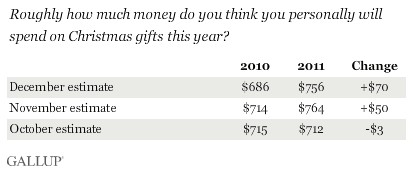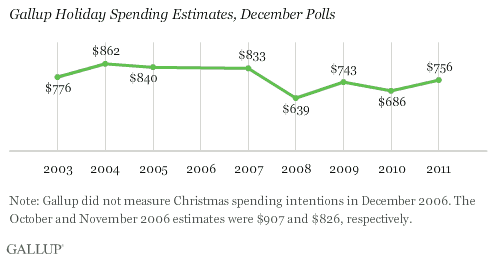PRINCETON, NJ -- Gallup's final update on expected holiday spending indicates 2011 will be a stronger year than 2010. Currently, Americans estimate they will spend $756 on gifts this year, up from $686 in December 2010. This reinforces the finding from November, which also showed higher estimates for 2011 than for 2010. The initial October estimate suggested spending would be similar to last year.

These results are based on a Dec. 15-18 Gallup poll. Gallup has asked Americans about their holiday spending intentions periodically since 1989, and yearly since 1998. An analysis of the historical Gallup estimates versus data on actual holiday retail sales suggests the former gives a broad indication of whether holiday sales will be improved versus the prior year.
The $70 increase in the mean spending intentions in the latest poll compared with December 2010 points to a stronger holiday spending season than last year, and is the highest December estimate Gallup has measured since before the 2008 recession. However, the current estimate remains below those Gallup measured in December 2003-2007, which were usually above $800.

A separate follow-up question in the poll asks Americans directly, after they give their dollar estimate, whether that is more than, less than, or the same as last Christmas. As is typically the case, the largest percentage say they will spend the same this year (48%), with the next largest saying they will spend less (33%), leaving 18% who say they will spend more.
However, this year's data are a bit more positive from an economic perspective than those from recent years: the 18% who say they will spend more is the highest since before the recession, and the 33% saying they will spend less, the lowest.

Gallup Daily Spending Measure Also Up
The conclusion that this will be a better holiday spending season than in the past is also supported by Gallup's daily spending measure, which asks Americans to report how much they spent the prior day, excluding bills and major purchases such as a home or automobile. Since the week of Thanksgiving, Americans have reported spending an average of $77 per day in 2011. That is up from $72 over the same period in 2010 and $73 for the same period in 2009.
Implications
Three separate Gallup measures of holiday spending all point to a stronger holiday spending season this year than in recent years, though possibly not quite as strong as before the recession.
Perhaps related to Americans' reports of greater spending this holiday season is a rise in Gallup's Economic Confidence Index, which, at -36 last week, is the least negative Gallup has measured since mid-July, before Americans' economic confidence was shaken by the debt-ceiling-limit negotiations, the downgrading of the U.S. credit rating, and subsequent drops in the stock market.
Because at least a partial weekend remains before the actual Christmas holiday, the 2011 holiday spending season could finish on a strong note. Last year, when the holiday fell on a Saturday, Gallup's weekly spending estimate for Christmas week showed an increase from the prior week. If that pattern occurs this year, with spending apparently already higher than in the prior two years, retailers will have much more to celebrate on Christmas.
Survey Methods
Results for this Gallup poll are based on telephone interviews conducted Dec. 15-18, 2011, with a random sample of 1,019 adults, aged 18 and older, living in all 50 U.S. states and the District of Columbia.
For results based on the total sample of national adults, one can say with 95% confidence that the maximum margin of sampling error is ±4 percentage points.
Interviews are conducted with respondents on landline telephones and cellular phones, with interviews conducted in Spanish for respondents who are primarily Spanish-speaking. Each sample includes a minimum quota of 400 cell phone respondents and 600 landline respondents per 1,000 national adults, with additional minimum quotas among landline respondents by region. Landline telephone numbers are chosen at random among listed telephone numbers. Cell phone numbers are selected using random-digit-dial methods. Landline respondents are chosen at random within each household on the basis of which member had the most recent birthday.
Samples are weighted by gender, age, race, Hispanic ethnicity, education, region, adults in the household, and phone status (cell phone only/landline only/both, cell phone mostly, and having an unlisted landline number). Demographic weighting targets are based on the March 2010 Current Population Survey figures for the aged 18 and older non-institutionalized population living in U.S. telephone households. All reported margins of sampling error include the computed design effects for weighting and sample design.
In addition to sampling error, question wording and practical difficulties in conducting surveys can introduce error or bias into the findings of public opinion polls.
View methodology, full question results, and trend data.
For more details on Gallup's polling methodology, visit www.gallup.com.
